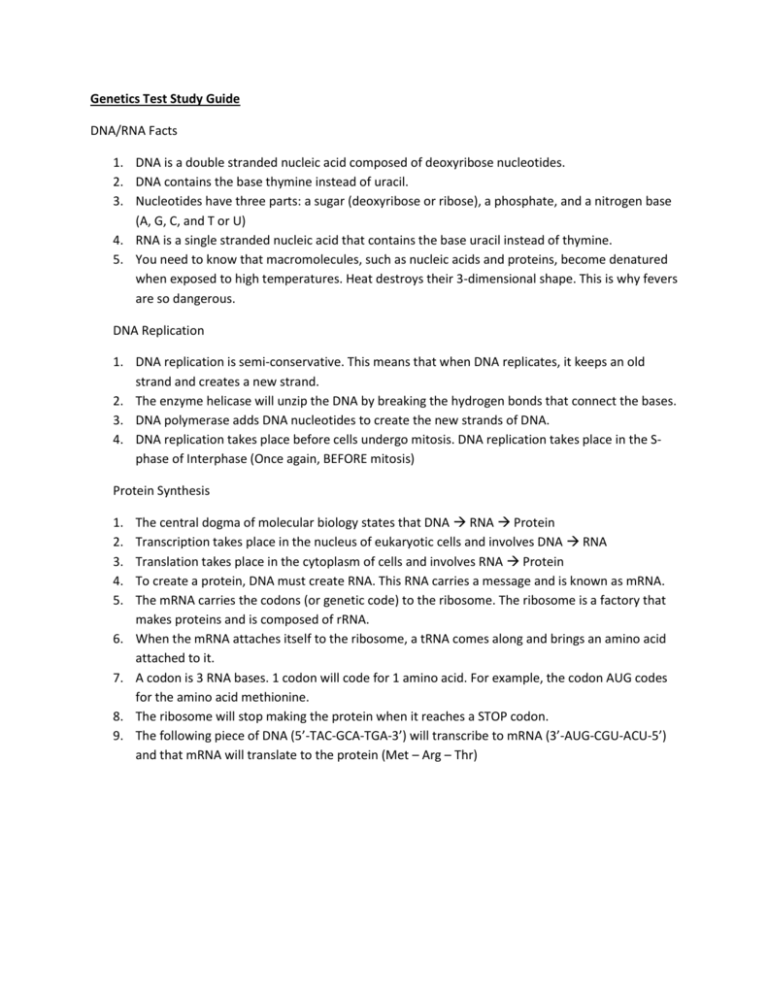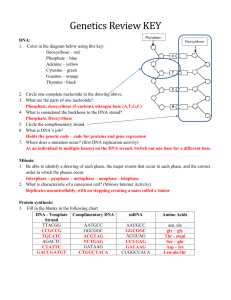Genetics Test Study Guide - Mater Academy Lakes High School
advertisement

Genetics Test Study Guide DNA/RNA Facts 1. DNA is a double stranded nucleic acid composed of deoxyribose nucleotides. 2. DNA contains the base thymine instead of uracil. 3. Nucleotides have three parts: a sugar (deoxyribose or ribose), a phosphate, and a nitrogen base (A, G, C, and T or U) 4. RNA is a single stranded nucleic acid that contains the base uracil instead of thymine. 5. You need to know that macromolecules, such as nucleic acids and proteins, become denatured when exposed to high temperatures. Heat destroys their 3-dimensional shape. This is why fevers are so dangerous. DNA Replication 1. DNA replication is semi-conservative. This means that when DNA replicates, it keeps an old strand and creates a new strand. 2. The enzyme helicase will unzip the DNA by breaking the hydrogen bonds that connect the bases. 3. DNA polymerase adds DNA nucleotides to create the new strands of DNA. 4. DNA replication takes place before cells undergo mitosis. DNA replication takes place in the Sphase of Interphase (Once again, BEFORE mitosis) Protein Synthesis 1. 2. 3. 4. 5. 6. 7. 8. 9. The central dogma of molecular biology states that DNA RNA Protein Transcription takes place in the nucleus of eukaryotic cells and involves DNA RNA Translation takes place in the cytoplasm of cells and involves RNA Protein To create a protein, DNA must create RNA. This RNA carries a message and is known as mRNA. The mRNA carries the codons (or genetic code) to the ribosome. The ribosome is a factory that makes proteins and is composed of rRNA. When the mRNA attaches itself to the ribosome, a tRNA comes along and brings an amino acid attached to it. A codon is 3 RNA bases. 1 codon will code for 1 amino acid. For example, the codon AUG codes for the amino acid methionine. The ribosome will stop making the protein when it reaches a STOP codon. The following piece of DNA (5’-TAC-GCA-TGA-3’) will transcribe to mRNA (3’-AUG-CGU-ACU-5’) and that mRNA will translate to the protein (Met – Arg – Thr) Mutations 1. A mutation is an error or mistake in the DNA. 2. A point mutation is also known as a substitution mutations. These mutations can be silent (nonharmful because the change results in the same amino acid), missense (the change results in a new amino acid), or nonsense (the change results in a stop) 3. Any mutation that involves an insertion or deletion of a base will cause a frameshift. Frameshift mutations are extremely dangerous because it can change the entire protein. Heredity 1. Sex-linked traits are written with superscripts XNXN or XnY. When you see a problem that says “Sex-linked,” but does not specify if the condition is X-linked or Y-linked, assume the condition is on the X chromosome. 2. The letters XX represent a female and XY represent a male. Some females are carriers for certain recessive disease, such as Adrenoleukodystrophy or Hemophilia. These females are carriers of the disease but do not have the disease. You can write them like this XNXn. In this example the superscript “N” indicates normal while the small “n” indicates the recessive allele for the disease. 3. Codominance is also written with superscripts. We use the big letter “I” to indicate dominance and the little letter “i” to represent recessive or blood type O. In order for a person to have blood type O, the person must be ii. 4. Blood type A can be homozygous IAIA or heterozygous IAi 5. Blood type B can be homozygous IBIB or heterozygous IBi 6. Blood type AB is codominant and looks like this IAIB 7. Blood type O looks like this ii. 8. To solve a dihybrid cross, you must use foil. Remember that dihybrid crosses involve two traits, such as color (yellow or green) and shape (round or wrinkly). You need the 16 boxes for this Punnett square. Foil YyRr = YR, Yr, yR, and yr 9. The Law of Dominance states that a dominant allele will be seen phenotypically. For example, if you have Yellow (dominant) and Green (recessive), then the offspring will be Yellow if the child’s genotype is heterozygous (Yy = yellow). Pedigrees 1. In a pedigree, the square represents a male and the circle represents a female. 2. If the shape in the pedigree (square or circle) is shaded completely, then that individual has the disease. 3. First determine if the pedigree is dominant or recessive. If the pedigree is dominant, the condition will most likely be seen in all generations (but be careful because there may be exceptions). You know a condition is recessive if the children have it and none of the parents have it. 4. After you determine if the pedigree is dominant or recessive, you must determine if the pedigree is autosomal or sex-linked. If the disease in the pedigree is sex-linked, you will see it more in one sex than the other (for the EOC: you will look for sex linked if almost all boys have it and almost no girls have it). If the disease is evenly distributed among both sexes, then the disease is autosomal.









